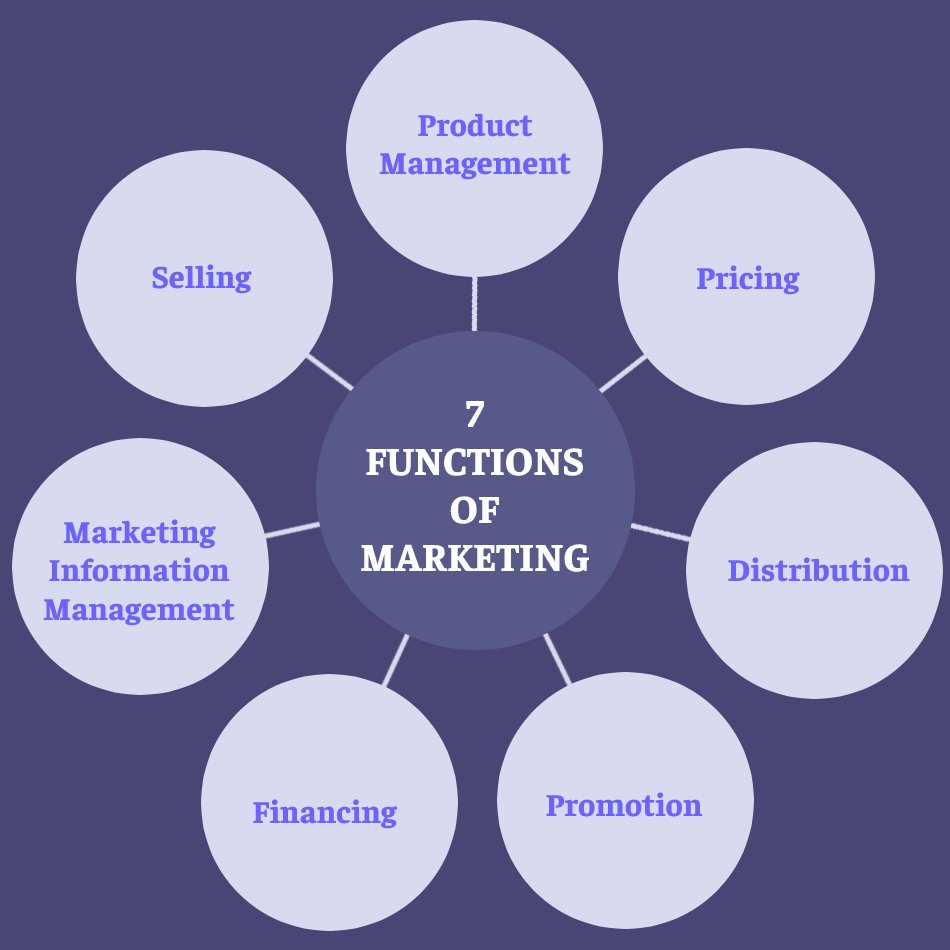
Marketing plays a crucial role in the success of any business, serving as the bridge between a company and its target audience. To effectively carry out this role, marketers need to understand the various functions of marketing. The marketing field encompasses various activities and strategies aimed at promoting and selling products or services. In this blog post, we will explore the 7 functions of marketing and discuss how each one contributes to the overall success of a business. Whether you are a business owner, a marketing professional, or simply interested in understanding the inner workings of marketing, this article is for you.
7 Functions Of Marketing

The 7 functions of marketing encompass the core activities and processes that businesses undertake to identify, anticipate, and satisfy customer needs while achieving their organizational goals. Each function plays a crucial role in guiding the overall marketing strategy and ensuring the success of products or services in the marketplace.
These functions of marketing work cohesively to drive business growth, enhance customer experiences, and achieve strategic objectives in a dynamic and competitive market. Each function requires careful planning, execution, and continuous evaluation to adapt to evolving market conditions and consumer preferences.
These functions encompass various stages of the marketing process and contribute to achieving organizational goals. The 7 functions of marketing are:
Function #1: Market Research
Market research stands as the foundational pillar upon which successful strategies are built. Market research isn’t just about gathering data; it’s about uncovering insights that drive informed decision-making and shape the direction of businesses. Let’s explore why market research is paramount in today’s competitive marketplace.
Understanding The Customer Landscape And Identifying Opportunities
At its core, market research provides businesses with a deep understanding of their target audience. Companies can gain valuable insights into what makes their customers tick by analyzing demographics, psychographics, and behavioral patterns. From preferences and pain points to purchasing behaviors and trends, market research unveils marketing information management, forming the bedrock of effective marketing strategies.
Market research serves as a compass, guiding businesses towards untapped opportunities and unmet needs within the marketplace. By conducting thorough market analysis, companies can identify emerging trends, competitive landscapes, and areas where demand outpaces supply. With this knowledge, businesses can tailor their offerings to address specific customer needs, thereby gaining a competitive edge in the market.
Mitigating Risks And Uncertainties
In today’s fast-paced business environment, risks and uncertainties abound. However, market research equips businesses with the insights needed to confidently navigate these challenges. Companies can anticipate potential roadblocks by assessing market dynamics, consumer sentiments, and industry trends and devise contingency plans to mitigate risks effectively. Whether it’s entering a new market, launching a new product, or adapting to changing consumer preferences, market research provides the clarity needed to make informed decisions.
Enhancing Marketing Effectiveness And Driving Business Growth
Effective marketing hinges on relevance and resonance—two qualities market research helps businesses achieve. By understanding their target audience’s wants, needs, and desires, companies can craft messaging that resonates with consumers on a personal level. Market research informs every aspect of the marketing mix, from product development and pricing strategies to promotional tactics and distribution channels. This ensures that resources are allocated efficiently and campaigns yield maximum impact.
Ultimately, market research aims to drive business growth and foster long-term success. By continuously monitoring market trends, tracking competitor activities, and soliciting customer feedback, businesses can adapt and evolve in response to changing market dynamics. Whether it’s expanding into new territories, refining existing offerings, or innovating to meet evolving customer demands, market research provides the strategic insights needed to fuel growth and stay ahead of the curve.
Function #2: Product Development
Once market research has been conducted and a target audience has been defined, the next function of marketing is product development. This involves creating and designing new products or improving existing ones to meet the needs and preferences of the target market.
Product development starts with idea generation, where businesses develop new concepts and innovations that can meet customer demands. These ideas are then evaluated based on feasibility, market potential, and profitability.
Once a viable idea has been identified, businesses move on to the design and creation phase. This includes developing prototypes, conducting testing and quality control, and refining the product until it meets the desired standards.
The aim of product and service management is to create offerings that are not only attractive and useful to customers but also unique and differentiated from competitors. It is crucial for businesses to continually innovate and adapt their products to stay relevant and meet changing customer needs.
Function #3: Pricing And Finance
After product development, the following function of marketing is pricing. Determining the right price for a product or service requires careful consideration of various factors such as production costs, competition, market demand, and customer perception of value.
Pricing strategies can vary depending on the goals of the business. Some companies opt for a cost-based approach, calculating all the expenses incurred during production and adding a profit margin. Others choose a market-based approach, where they analyze the prices of similar products and set their prices accordingly.
Businesses need to strike a balance between profitability and affordability. Setting prices too high may deter customers while setting them too low could decrease profit margins.
In addition to pricing, the finance aspect of marketing involves managing the business’s financial resources to support marketing activities. This includes budgeting, financial analysis, and allocation of funds for marketing campaigns, promotions, and advertising.
Function #4: Promotion And Advertising
Once the pricing and finance aspects of marketing have been established, the next function is promotion and advertising. This function is crucial for creating awareness and generating interest in the product or service.
Promotion involves various tactics to communicate with the target audience and persuade them to purchase. Advertising, a subset of promotion, utilizes paid channels such as TV, radio, print media, and digital platforms to reach a wider audience.
To create effective promotional strategies, marketers conduct market research to understand the needs and preferences of their target market. This enables them to tailor their messages and select the most appropriate channels to engage with their audience.
Promotion and advertising also involve developing persuasive messaging, creating attractive visuals, and selecting the right media mix to maximize reach and impact. Through these activities, businesses generate brand awareness, communicate product benefits, and ultimately drive sales.
Function #5: Distribution And Sales
Once the promotion and advertising strategies have been implemented, the next crucial function of marketing is distribution and sales. This function focuses on getting the product or service to the target market as efficiently and effectively as possible.
Distribution involves the entire process of moving the product from the manufacturer to the end consumer. This includes transportation, warehousing, inventory management, and order fulfilment. Marketers must determine the most appropriate distribution channels based on cost, accessibility, and customer preferences.
Sales, on the other hand, involves the actual selling of the product or service to customers. This requires a skilled salesforce to effectively communicate the value proposition and handle customer objections or concerns. Sales representatives may engage in direct selling, retail selling, or e-commerce selling, depending on the nature of the product and the target market.
By optimizing distribution and sales processes, businesses can ensure that their products are available in the right place, at the right time, and in the right quantities. This function ultimately contributes to customer satisfaction and loyalty, as well as the overall success of the marketing strategy.
Function #6: Customer Service
Once the product or service has been sold and delivered, the following important marketing function is customer service. This function focuses on ensuring customer satisfaction and maintaining positive relationships with customers.
Customer service involves providing customer support, assistance, and solutions throughout company interactions. This may include addressing inquiries, resolving complaints, providing product information, or offering technical support. Effective customer service can help build trust, loyalty, and repeat business.
Marketers must prioritize customer needs and ensure proper training and resources are in place to deliver exceptional customer service. This function should be aligned with the overall marketing strategy and goals, as satisfied customers can become brand advocates and help drive business growth.
Function #7: Relationship Building
The last and final function of marketing is relationship building. This function nurtures long-term and mutually beneficial relationships with customers, suppliers, and other stakeholders.
Relationship building involves creating and maintaining strong connections with individuals or organizations crucial to the business’s success. This can be achieved through various activities such as networking, collaboration, partnerships, and relationship management.
Marketers can establish trust, enhance communication, and create opportunities for collaboration and growth by investing time and effort into building relationships. Strong relationships can increase customer loyalty, word-of-mouth referrals, and new business opportunities.
To effectively build relationships, marketers must understand the needs and preferences of their stakeholders and tailor their strategies accordingly. This function should be integrated into the marketing plan to ensure consistency and effectiveness.
Understanding and implementing these 7 functions of marketing can help businesses optimize their marketing efforts and achieve their goals.
FAQs
Q1: Why is product planning and development important in the seven functions of marketing?
A1: Product planning and development are crucial because they involve creating products or services that meet the needs and preferences of target customers. Effective product planning ensures businesses offer innovative and valuable solutions that differentiate them from competitors and satisfy customer demands.
Q2: How does pricing impact marketing strategy?
A2: Pricing plays a significant role in the 7 functions of marketing strategy, influencing consumer perception of value, brand positioning, and profitability. Businesses must consider factors such as production costs, competitor pricing, and customer willingness to pay when setting prices to maximize revenue and remain competitive.
Q3: What is the role of promotion in 7 functions of marketing?
A3: Promotion involves various activities and communication channels to inform, persuade, and influence target customers to purchase products or services. It includes advertising, sales promotions, public relations, and digital marketing tactics to raise brand awareness, generate interest, and drive sales.
Q4: How does distribution contribute to marketing success?
A4: Distribution ensures that products or services reach customers efficiently and effectively. It involves decisions related to channel selection, inventory management, and retailing strategies to ensure products are available in the right place, at the right time, and in the right quantities to meet customer demand.
Conclusion
In conclusion, the 7 functions of marketing are essential for businesses to successfully promote and sell their products or services. Each function plays a crucial role in achieving marketing objectives, from analyzing market trends and consumer behaviour to developing pricing strategies and implementing promotional campaigns.
By understanding and incorporating the 7 functions of marketing, businesses can effectively reach their target audience, create value, build brand awareness, and drive sales and revenue. It is vital for marketers to constantly evaluate and adapt their strategies to stay competitive in an ever-evolving marketplace.
Overall, marketing functions provide a framework for businesses to identify opportunities, create meaningful connections with customers, and build a strong brand presence. By leveraging these functions, companies can position themselves for success and achieve their desired outcomes.
So, above are the 7 functions of marketing. We hope you found it informative and valuable for your marketing endeavours. Stay tuned for more insightful content in the future!








No Comments